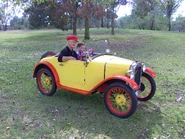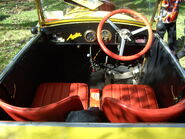The Austin 7 was built by the Austin Motor Company in several body styles, including a Van version.
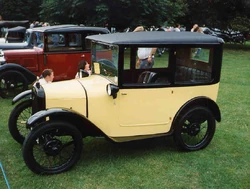 | |
| Manufacturer | Austin Motor Company |
|---|---|
| Production |
1922–1939 290,000 |
| Predecessor | None |
| Successor | Big 7 |
| Class | Microcar |
| Body style(s) | various including vans |
| Engine(s) | 747 cc straight-4 |
| Wheelbase | 75 inches (1.905 m) |
The Austin 7 or as the grill badge says Austin Seven was a vintage car produced from 1922 through to 1939 in the United Kingdom by the Austin Motor Company. Nicknamed the "Baby Austin", It was one of the most popular cars ever produced there and wiped out most other British small cars and cyclecars of the early 1920s[1], its effect on the British market was similar to that of the Model T Ford in the USA. It was also licensed and copied by companies all over the world [2]. The first BMW models (BMW Dixi) were licensed Austin 7s, as were the original American Austins. In France they were made and sold as Rosengarts while in Japan Nissan also used the 7 design as the basis for their original cars, though not under licence [2].
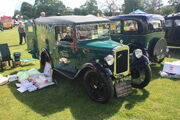
A restored Austin 7 van at the Boroughbridge Classic Vehicle show 2009
After World War II, many Austin 7s were rebuilt as "specials"[3][4][5] including the first Lotus, the Lotus Mk1 which was based on an Austin 7.
Such was the power of the Austin 7 name that the company re-used it for early versions of both the A30 in 1951 [6] and Mini in 1959.
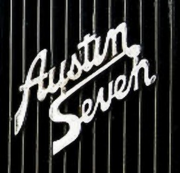
History[]
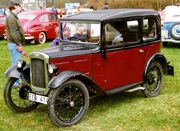
Austin 7 Saloon 1931
Austin had, before World War I, built mainly large cars but in 1909 they sold a single cylinder 7 hp built by the Swift of Coventry called the Austin Seven.[7] After this they returned to bigger cars, but Sir Herbert Austin felt a smaller car would be more popular, in spite of protestations from the company's board of directors who were concerned about the financial status of the company. Austin won them over by threatening to take the idea to their competitor Wolseley, and got permission to start on his design, in which he was assisted by a young draughtsman called Stanley Edge who worked from 1921 into 1922 at Austin's home, Lickey Grange. Austin put a large amount of his own money into the design and patented many of its innovations in his own name. In return for the investment he was paid a royalty of two guineas (£2, 2s), (£2.10) on every car sold.[2]
Nearly 2500 cars were made in the first year of production (1923), not as many as hoped, but within a few years the "big car in miniature" had wiped out the cyclecar industry and transformed the fortunes of the Austin Motor Co. By 1939 when production finally ended, 290,000 cars and vans had been made.
Media[]
In 2007, during an episode of Top Gear, Jeremy Clarkson and James May studied a number of early car designs (including the Ford Model T and the De Dion-Bouton Model Q and concluded that the Austin Seven was the first mass-market car to be fitted with a 'conventional' control layout, as found on modern cars (although the earliest car they found to use this layout was a Cadillac).
Chassis[]
The Austin 7 was considerably smaller than the Ford Model T. The wheelbase was only 6 ft 3 inches (1.905 m), and the track only 40 inches (1.016 m). Equally it was lighter - less than half the Ford's weight at 794 pounds (360 kg). The engine required for adequate performance was therefore equally reduced and the 747 cc sidevalve was quite capable with a modest 10 hp output.
The chassis took the form of an "A" with the engine mounted between the channel sections at the narrow front end. The rear suspension was by quarter elliptic springs cantilevered from the rear of the chassis while at the front the beam axle had a centrally mounted half elliptic transverse spring. Early cars did not have any shock absorbers. Brakes were on all wheels but at first the front brakes were operated by the handbrake and the rear by the footbrake, becoming fully coupled in 1930.
Steering is by worm and wheel mechanism.
Engine and transmission[]
The four cylinder 747 cc, 56 mm bore by 76 mm stroke, side valve engine was composed of an aluminium crankcase, cast iron cylinder block and cast iron cylinder head. The splash lubricated crankshaft (pressure fed on some sports models) at first ran in two bearings changing to three in 1936. An electric starter was fitted from November 1923 and although the early cars used magneto ignition, this changed to coil in 1928.
The 3 speed and reverse gearbox was built in-unit with the engine and had a variety of ratios depending on application. A four speed gearbox was introduced in 1932 and in 1933 synchromesh was added to third and top ratios extending to second gear in 1934.
The back axle was of spiral bevel type with ratios between 4.4:1 and 5.6:1. A short torque tube runs forward from the differential housing to a bearing and bracket on the rear axle cross member.
Reliant used a derivative of the Austin Seven engine for their early three-wheelers, before developing an aluminium alloy engine (used as the replacement for the Austin Seven engine by the 750 Motor Club in their Formula 750 motor sport).
The Swallow[]
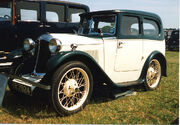
1931 Austin 7 Swallow saloon
In 1927, William Lyons, co-founder of the Swallow Sidecar Company, saw the commercial potential of producing a rebodied Austin 7. Lyons commissioned the talented coachbuilder Cyril Holland to produce a distinctive open tourer: the Austin Seven Swallow.
With its bright two-tone colour scheme and a style in befitting more expensive cars of the time, together with its low cost (£175), the Swallow proved popular and was followed in 1928 by a saloon version: the Austin Seven Swallow Saloon.
Approximately 3500 bodies of various styles were produced up until 1932 when Lyons started making complete cars under the SS brand.
Such was the demand for the Austin Seven Swallows that Lyons was forced to move in 1928 from Blackpool to new premises in Coventry. It was, in part, the success of the Swallows that laid the foundations of what was to become, by 1945, Jaguar Cars [8] [9]
Licensed production[]
Versions of the Austin 7 were made under licence by American Austin from 1930, Dixi (later bought by BMW) in Germany from 1927 and Rosengart in France from 1928. In addition, chassis and running gear were exported to Japan and Australia to have locally made bodies attached.
Body styles [2][]
Tourers[]
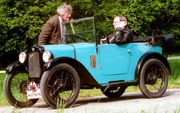
Austin 7 Chummy Tourer 1929

1934 Austin 7 two seater (pre-Opal)
| Type | Name | Description | From | To |
|---|---|---|---|---|
| XL | prototypes | 1922 | ||
| AB | Aluminium body four seater | 1922 | 1924 | |
| AC | 1924 | 1926 | ||
| AD | Four seater | 1926 | 1929 | |
| AE | Four seater. Two inches wider than AD | 1929 | 1929 | |
| Two seater | 1929 | 1930 | ||
| AF | Steel bodied Four seater | 1930 | 1932 | |
| AH | Pressed steel body. Four seater | 1932 | ||
| AAK | Open road Tourer | Cowled radiator | 1934 | |
| AH | Pressed steel body. Four seater | 1932 | ||
| PD | Two seater | 1934 | ||
| APD | Opal | Two seater | 1934 | 1936 |
| AAL | Open Road Tourer | Covered spare wheel | 1935 | |
| AH | Pressed steel body. Four seater | 1932 | ||
| APE | New Opal | Two seater | 1936 |
Saloons[]
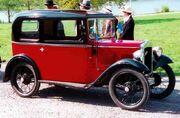
Austin 7 Box Saloon 1933

Austin 7 "New Ruby" saloon
| Type | Name | Description | From | To |
|---|---|---|---|---|
| R | Aluminium or fabric saloon | 1926 | 1927 | |
| RK | Aluminium or fabric saloon | 1927 | ||
| RL | Steel saloon | 1930 | ||
| RG | Fabric saloon | 1930 | ||
| RN | Long wheelbase steel saloon | |||
| RP | 1932 | |||
| ARQ | Ruby | Saloon | 1934 | |
| ARR | "New" Ruby | Saloon | 1936 |
Cabriolet[]

Austin 7 Pearl Cabriolet 1935
| Type | Name | Description | From | To |
|---|---|---|---|---|
| AC | Pearl | Cabriolet version of ARQ Ruby. | 1934 | |
| ACA | "New" Pearl | Cabriolet version of ARR New Ruby. | 1936 |
Sports[]

Austin 7 Ulster 2-Seater Sports 1930
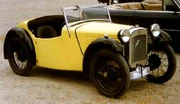
Austin 7 Nippy 2-Seater Sports 1934
| Type | Name | Description | From | To |
|---|---|---|---|---|
| 50 mph | Aluminium bodied. Long tail | 1926 | ||
| E Super Sports | Aluminium bodied. No doors | 1927 | 1928 | |
| EA Sports | Ulster | Aluminium bodied. No doors | ||
| EB 65 | 65 | Aluminium body, steel wings. Rounded tail. | 1933 | 1934 |
| AEB | Nippy | All steel | 1934 | 1937 |
| EK 75 | Speedy | Aluminium body. Pointed tail. | ||
| AEK | Speedy | Redesignation of EK 75 | 1935 |
Coupés[]
| Type | Name | Description | From | To |
|---|---|---|---|---|
| Type B | Upper body fabric. | 1928 | 1931 |
Vans[]
| Type | Name | Description | From | To |
|---|---|---|---|---|
| AB, AC and AD | Converted tourer | 1923 | 1927 | |
| AE | 1929 | 1930 | ||
| RK | Converted RK saloon | |||
| RM | Converted RL saloon | |||
| RN | Converted RN saloon | |||
| RP | Converted RP saloon | 1933 | ||
| AVH | ||||
| AVJ and AVK | Converted Ruby | 1939 |
Gallery[]
Preservation[]
There are many examples in preservation in Britain and in other countries around the world. A lot of the UK cars are rebuilt from several vehicles.
Known vehicles in preservation[]
Please list any surviving vehicles here, with were seen and the registration number to identify them.
- ADD 977 - Austin 7 Van - seen at Llandudno Transport Festival 2008
- FLB 227 - Seen at Renishaw Hall Classic Car Show 2011
- HPG 98+ - Ruby van at Rushden Transport Cavalcade 2008
- JSV 889 - seen at Wollaton Park Steam Rally 2011
- YJ 3360+ - Austin 7 Van of 1936 at Boroughbridge Classic Vehicle show 2009
References[]
- ↑ Baldwin, N. (1994). A-Z of Cars of the 1920s. Devon, UK: Bay View Books. ISBN 1-870979-53-2.
- ↑ 2.0 2.1 2.2 2.3 Mills, Rinsey (1996). Original Austin Seven. Bideford, Devon: Bay View Books. ISBN 1-870979-68-0.
- ↑ Classic Motor Monthly: The Super Accessories
- ↑ The Austin Seven Special
- ↑ Austin 7 Special
- ↑ Robson, Graham (2006). A-Z British Cars 1945-1980. Devon, UK: Herridge & Sons. ISBN 0-9541063-9-3.
- ↑ Georgano, N. (2000). Beaulieu Encyclopedia of the Automobile. London: HMSO. ISBN 1-57958-293-1.
- ↑ Sedgwick, M. (1989). A-Z of Cars of the 1930s. Devon, UK: Bay View Books. ISBN 1-870979-38-9.
- ↑ Jaguar History: Swallow Sidecar Company (Retrieved 18 July 2007)
External links[]
- The Austin 7 Clubs Association Details of the various A7 member clubs throughout the UK and the rest of the world.
- The Pre-War Austin 7 Club The largest club purely for the Austin Seven.
- Andy's Austin Seven Page Contains details of Austin Seven clubs, events, suppliers of spare parts and books.
- A7 Components Spare parts for all models of Austin 7.
| Austin range v • t • e | ||||||||||||||||||||
|---|---|---|---|---|---|---|---|---|---|---|---|---|---|---|---|---|---|---|---|---|
| ||||||||||||||||||||
| |||||||||||||||||||||||||||||||||||||||||||||||
| This page uses some content from Wikipedia. The original article was at Austin 7. The list of authors can be seen in the page history. As with Tractor & Construction Plant Wiki, the text of Wikipedia is available under the Creative Commons by Attribution License and/or GNU Free Documentation License. Please check page history for when the original article was copied to Wikia |
